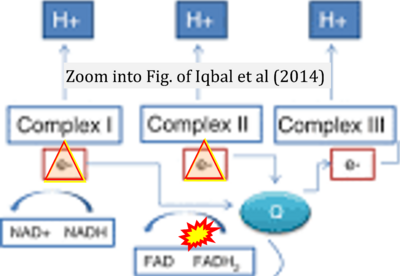Difference between revisions of "Iqbal 2014 Springer, New York"
(Created page with "{{Publication |title=Iqbal T, Welsby PJ, Howarth FC, Bidasee K, Adeghate E, Singh J (2014) Effects of diabetes-induced hyperglycemia in the heart: biochemical and structural s...") |
|||
| Line 8: | Line 8: | ||
|editor=Gnaiger E | |editor=Gnaiger E | ||
}} | }} | ||
[[File:Iqbal 2014 Springer, New York CORRECTION.png|right|400px]] | [[File:Iqbal 2014 Springer, New York CORRECTION.png|right|400px]] | ||
{{Template:Correction FADH2 and S-pathway}} | {{Template:Correction FADH2 and S-pathway}} | ||
Revision as of 15:40, 19 December 2023
| Iqbal T, Welsby PJ, Howarth FC, Bidasee K, Adeghate E, Singh J (2014) Effects of diabetes-induced hyperglycemia in the heart: biochemical and structural slterations. Springer, New York In: Turan B, Dhalla N (eds) Diabetic cardiomyopathy. Advances in biochemistry in health and disease 9. https://doi.org/10.1007/978-1-4614-9317-4_5. |
» Springer
Iqbal T, Welsby PJ, Howarth FC, Bidasee K, Adeghate E, Singh J (2014) Springer, New York
Abstract: Hyperglycemia (HG) plays a major role in the development of diabetes mellitus (DM) and its complications. HG induces numerous maladaptations at the cellular level and moreover it is an independent risk factor to worsen cardiac performance and cell survival. The heart is a major target organ for damage with hyperglycemia. Alterations as a result of HG can lead to the development of a diabetic cardiomyopathy, resulting in changes to cardiac structure and function. Mechanisms damaging the heart are similar to those that damage the vasculature, but are more widespread in the myocardium. Four major pathways are implicated in HG-induced cardiac and vascular damage, including increases in advanced glycation end products (AGEs), enhanced hexosamine and polyol flux, and activation of classical isoforms of protein kinase C (PKC). These changes lead to abnormalities such as increased ventricular stiffness, cardiac fibrosis, derangement in cellular calcium ion homeostasis, and reduced myocyte contractility, resulting in heart failure (HF) over time. These pathways reflect upon a single HG-induced process of overproduction of superoxide by the mitochondrial electron-transport chain, which is responsible for the changes occurring in the heart. This chapter discusses the HG-induced pathways, focusing on their effects on the structure of the diabetic heart, as well as examining the downstream signaling whereby oxidative stress leads to myocardial fibrosis and impaired contractile function. In addition, this review highlights the role of endothelin-1 (ET-1) in endothelial dysfunction and the effects of humoral factors, angiotensin II and transforming growth factor-β, in evoking multiple signaling pathways in cardiac fibroblasts or fibrosis that leads to cardiac remodelling. How these signaling pathways mediated by HG contribute to the pathophysiological alterations in the heart is also discussed in this review.
• Bioblast editor: Gnaiger E
Correction: FADH2 and Complex II
- FADH2 is shown as the substrate feeding electrons into Complex II (CII). This is wrong and requires correction - for details see Gnaiger (2024).
- Gnaiger E (2024) Complex II ambiguities ― FADH2 in the electron transfer system. J Biol Chem 300:105470. https://doi.org/10.1016/j.jbc.2023.105470 - »Bioblast link«


